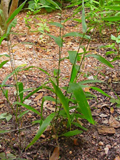Native Plants

Q. Who is Mr. Smarty Plants?
A: There are those who suspect Wildflower Center volunteers are the culpable and capable culprits. Yet, others think staff members play some, albeit small, role. You can torture us with your plant questions, but we will never reveal the Green Guru's secret identity.
Did you know you can access the Native Plant Information Network with your web-enabled smartphone?
Ask Mr. Smarty Plants is a free service provided by the staff and volunteers at the Lady Bird Johnson Wildflower Center.

rate this answer
Thursday - April 29, 2010
From: Whitehouse Station, NJ
Region: Northeast
Topic: Problem Plants, Grasses or Grass-like
Title: Aggressive native Inland Sea Oats in Whitehouse Station NJ
Answered by: Barbara Medford
QUESTION:
Can you direct me to a source of help managing a very aggressive grass, Chasmanthium latifolia, Woodland Oats or Indian Sea Oats. It is behaving like a very noxious plant and I am concerned as I am having trouble controlling it.ANSWER:
We are surprised to find someone wanting to get rid of Chasmanthium latifolium (Inland sea oats). In Texas, many gardeners love it, because it is one of the few grasses that really do well in shade, it looks good most seasons, and will virtually make a hedge with it's graceful stems and "oats" hanging over. However, everyone has their preferences and we will see what we can do to help you.
From Wayside Garden, we found this article Three Seasons of Showy Color for the Shade; they don't consider it invasive but several of the responders in Dave's Garden do. This Floridata site, Chasmanthium latifolium, conceded that it could be invasive if you had it in moist soil and sun, so that's at least a clue.
We found no one saying "This is a pest, and this is how to get rid of it," so we will have to do it. First, don't let it seed; in fact, keep it cut down very low. This can eventually starve it out, but it's a little slow. The roots are apparently fairly easy to transplant, so we're assuming they are also easy to dig out. If you have it growing in a garden situation, that is going to make it harder, because you may have to keep the soil moist for the garden plants, and don't want to disturb the other plant roots to dig up the grass roots. It can spread both by seeds and roots, you'll have to address it on both fronts. Since it is a grass, a member of the Poaceae family, you can purchase a weed killer for monocots, only; that is, grasses. When a plant has a good root system like this one does, it's difficult to get the herbicide to the roots. You might try cutting it down as much as you can, which eliminates seed, and then painting the stalks left in the ground with the herbicide and a small disposable paint brush. Be careful, though, your lawn is probably a grass, too, so we don't recommend spraying. Dig out as many of the roots as you can, and dispose of them where they won't regrow. You'll have to keep watching for it and grubbing it out as it comes up in the Spring.
From our Native Plant Image Gallery:
More Problem Plants Questions
Update on controlling live oak suckers with newspapers, cardboard and mulch
September 12, 2014 - Can we get an update on the march 2011 topic of live oak suckers? I am wondering if the newspaper/cardboard/mulch layers continued to take care of the problem. Thanks!
view the full question and answer
Bermuda, not the only option in Memphis
November 04, 2014 - I'm building an energy efficient home in Memphis and want to extend that strategy to the landscaping. I'd like to plant native grasses, but this lot is surrounded by lots sodded with Bermuda grass....
view the full question and answer
Treating stings from stinging nettles in Indiana
August 08, 2009 - How can I remove hairlike thorns (as from nettle-type weed)? My hands react within 24 hours with swelling and pain, esp in morning. In past when I have then been able to locate the offending thorn, th...
view the full question and answer
Eliminating non-native invasive Asian jasmine in Temple TX
February 06, 2010 - Hello, behind my backyard fence there is a large growth (about 300 to 400 sq feet) of Asian jasmine. It was planted by previous owners. It prevents growth of native plants like holly. What is the prac...
view the full question and answer
Dealing with live oak suckers in Central Texas
March 05, 2015 - Hi, I have a couple huge Live Oak trees in my back yard. Trunks are 4' in diameter. These Live Oaks produce a lot of root sprouts/suckers. I had always head that a tree's roots feed on water/oxyg...
view the full question and answer
| Support the Wildflower Center by Donating Online or Becoming a Member today. |


